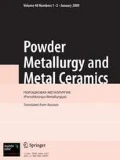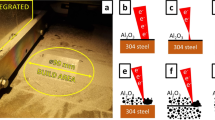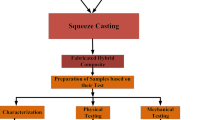Conclusions
The material made of the NiAl powders with the recrystallized structures has low strength and cracking resistance even if its porosity is high, similar to theoretical. This is caused by intercrystalline brittleness. The material with the aggregate structure has higher mechanical properties. Cracking resistance in the brittle-ductile transition range changes in relation to porosity which weakens the load-carrying cross section and localizes deformation.
Similar content being viewed by others
Literature cited
M. Slesar, “Fractographic features in fracture of sintered materials,” in: Fundamentals, Production, and Strength Properties of Powder Metallurgy Materials, Vol. 1, Institute of Solid-State Physical and Material Research, Dresden (1981), pp. 83–103.
M. Slesar and L. Parilak, “Metallurgical aspects of fracture toughness,” in: 6th International Powder Metallurgy Conference in Czechoslovakia [in Czech], Vol. 2 (1982), pp. 137–166.
K. I. Portnoi, V. P. Buntushkin, B. M. Zakharov, et al., “High-temperature materials and coatings based on intermetallic compounds of the nickel-aluminum system,” Poroshk. Metall., No. 2, 33–39 (1980).
E. M. Grell', “Examination of NiAl and Ni3Al,” in: Mechanical Properties of Metallic Compounds [in Russian], Metallurgizdat, Moscow (1962), pp. 266–275.
Yu. L. Krasulin, V. S. Ivanov, and S. M. Barinov, “Formation of structure of ceramic material in pulsed compacting of powders,” in: Fundamentals, Production, and Strength Properties of Powder Metallurgy Materials, Vol. 3, Institute of Solid-State Physics and Material Research, Dresden (1981), pp. 63–71.
E. S. Atroshenko, B. M. Barykin, V. S. Ivanov, et al., “The effect of explosive compacting on the properties of 60% LaCrO3-402 Cr cermet,” High Temp.-High Pressures,8, No. 1, 21–26 (1976).
K. I. Portnoi and B. N. Babich, Dispersion-Hardened Materials [in Russian], Metallurgiya, Moscow (1976).
S. M. Barinov and Yu. L. Krasulin, “A method of formation of a crack in the specimen for determining the fracture toughness of brittle material,” Zavod. Lab., No. 5, 75–76 (1982).
S. M. Barinov, “Determination of the mechanical characteristics of refractory materials in bending,” Zavod. Lab., No. 11, 78–80 (1982).
H. Pusch, “Test methods using fracture mechanics,” in: Testing of Materials (Handbook) [Russian translation], H. Blumenauer (ed.), Metallurgiya, Moscow (1979), pp. 92–111.
V. M. Markochev and E. M. Morozov, “Energy relations in deformation of a crack-containing specimen,” Probl. Prochn., No. 5, 66–70 (1980).
S. M. Barinov, “Determination of cracking resistance of refractory materials in the brittle-ductile transition range,” Zavod. Lab., No. 11, 65–70 (1983).
A. K. Bhalla and J. D. Williams, “A comparative assessment of explosive and other methods of compaction of the tungsten-copper composites,” Powder Metall.,19, No. 1, 31–37 (1976).
S. M. Barinov, V. S. Ivanov, Yu. L. Krasulin, et al., “Structure and temperature dependence of the mechanical properties of materials made of TiAl and NiAl powders,” Alloys of Refractory and Rare Metals for Service at High Temperatures [in Russian], Nauka, Moscow (1984), pp. 150–154.
D. J. Morris, “Sapid solidification phenomena,” Met. Sci.,16, No. 10, 457–464 (1982).
V. I. Trefilov, Yu. V. Mil'man, and S. A. Firstov, Physical Fundamentals of the Strength of Refractory Metals [in Russian], Naukova Dumka, Kiev (1975).
S. M. Barinov, “Effect of structure on failure of porous sintered materials,” Fiz. Khim. Obrab. Mater., No. 1, 140–141 (1984).
G. P. Cherepanov, Mechanics of Brittle Fracture [in Russian], Nauka, Moscow (1974).
J. F. Knott, Fundamentals of Fracture Mechanics [Russian translation], Metallurgiya, Moscow (1977).
Author information
Authors and Affiliations
Additional information
Translated from Poroshkovaya Metallurgiya, No. 8(284), pp. 97–104, August, 1986.
Rights and permissions
About this article
Cite this article
Krasulin, Y.L., Barinov, S.M., Siesar, M. et al. Structure and failure of nickel aluminide powder. Powder Metall Met Ceram 25, 694–699 (1986). https://doi.org/10.1007/BF00796745
Received:
Issue Date:
DOI: https://doi.org/10.1007/BF00796745




